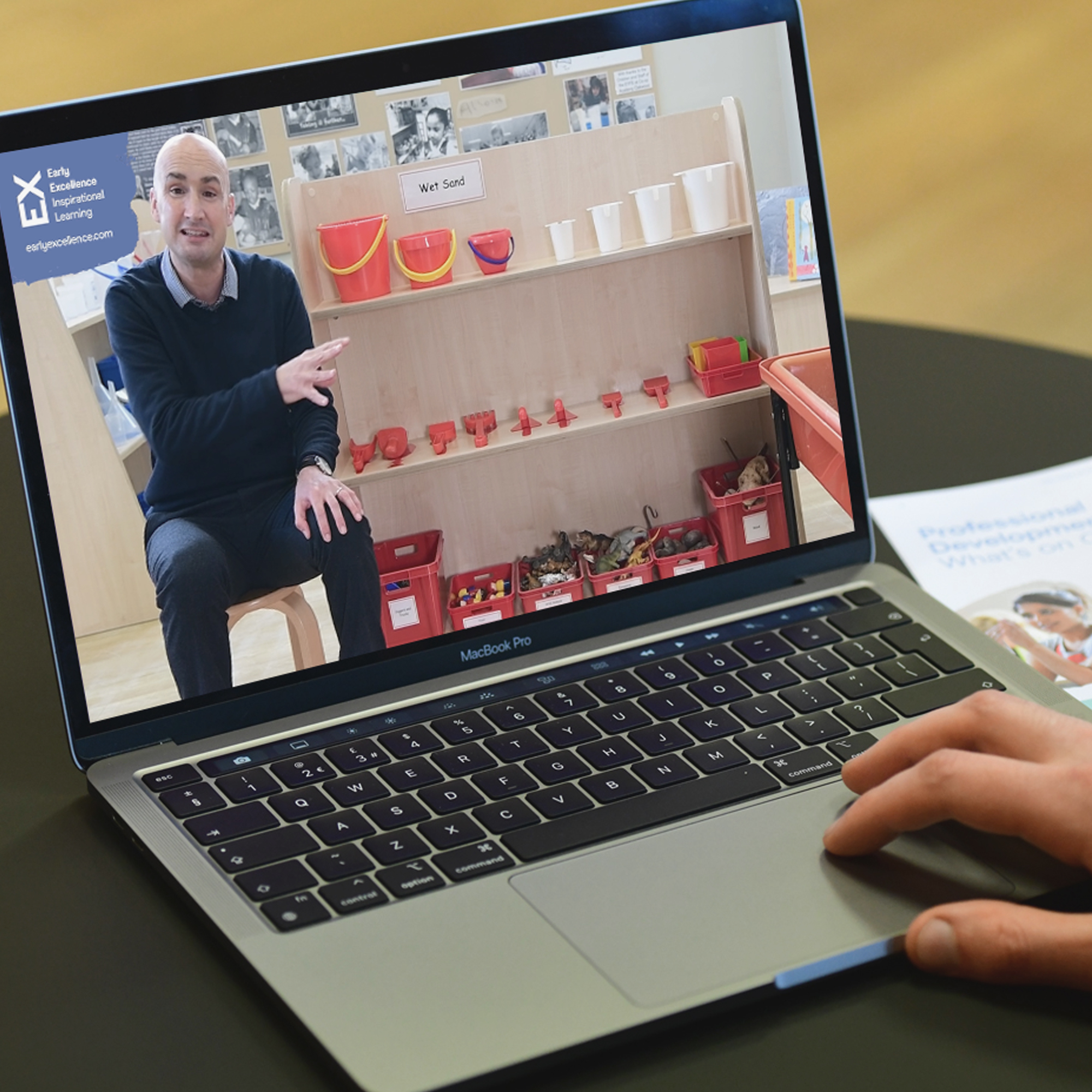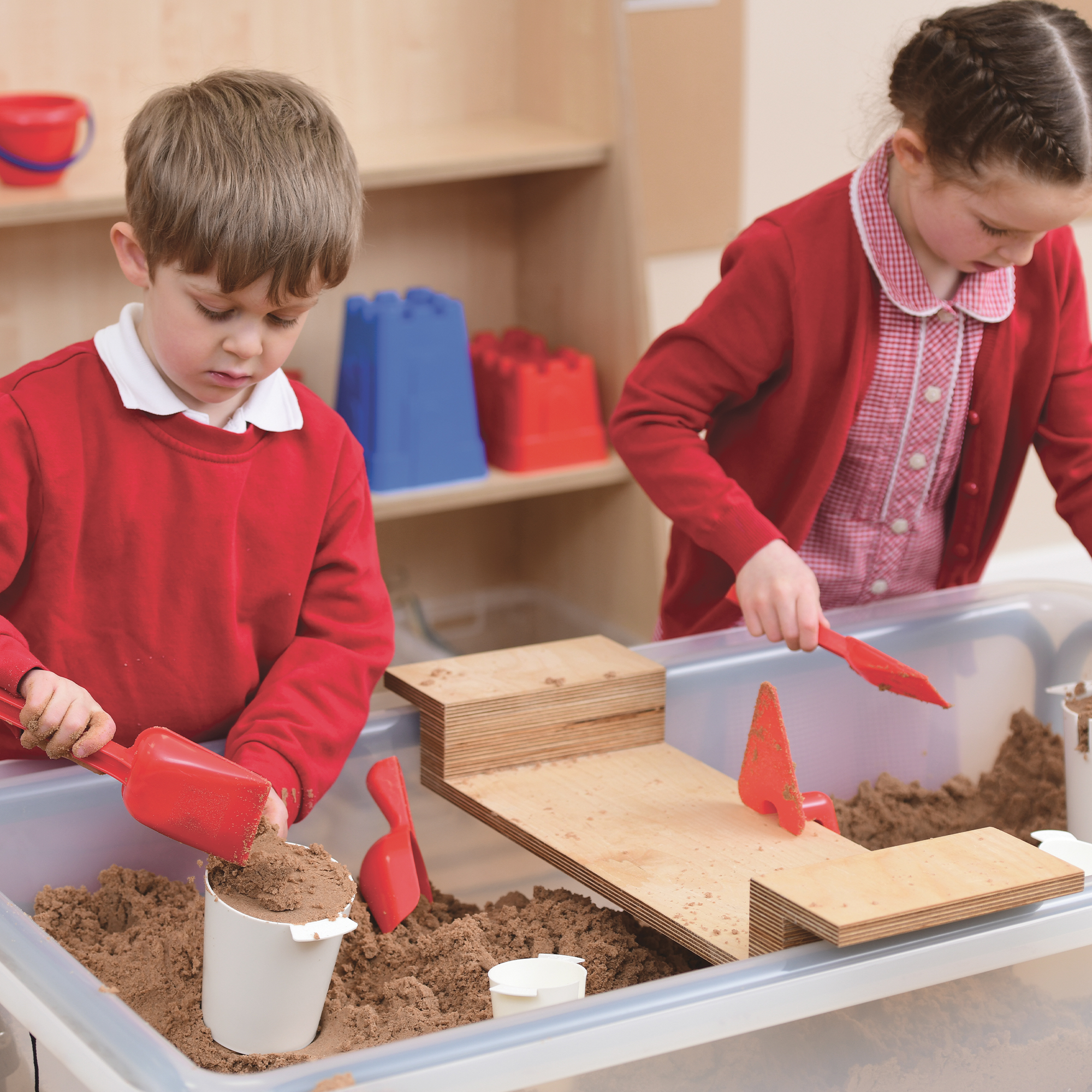When thinking about equipping your classroom to facilitate high-quality play, the starting point for most practitioners is to plan out their classroom and carefully consider where each area of continuous provision will go. At this point, you are often faced with the age-old dilemma of a lack of space, and naturally, you begin to consider which areas you may need to do without. Over and over again, it is sand play that is omitted, often transferred to the outdoor space due to the messy nature of sand play.
As practitioners, we must acknowledge that by placing a sand tray outside, we are simply moving indoor learning, outside. Outdoor sand play is rather different to indoor sand play. Outdoor sand should ideally be on a large scale, in a walk-in sand pit (if you have one), using life size tools such as spades that you can put your feet on and dig down deep – really physically challenging play. It should offer related contextual equipment such as bricks, measuring tools and things like spirit levels so that children can really understand how to use sand effectively outdoors and what its purpose is.
By putting a sand tray and indoor sand resources outside, we are not acknowledging the principles of outdoor learning and the value of indoor sand play is missed.
There are some great benefits to having both indoor sand areas and outdoor sand areas and it’s worth considering if you can make space for indoor sand in your classroom to maximise the impact of sand play upon the holistic development of children.
Indoor sand play can take two forms – dry sand and wet sand. There are benefits to having both a dry sand area and a wet sand area indoors, if space allows.
Benefits of Dry Sand Play
- Sensory Development: Dry sand play stimulates the senses, allowing children to explore different textures, temperatures, and consistencies. Manipulating sand helps enhance fine motor skills as children scoop, pour, sift, and build structures, refining their hand-eye coordination.
- Imagination and Creativity: Sand acts as a blank canvas for children’s imagination. Naturally, children will want to create small worlds in the dry sand, so providing resources such as desert animals, trucks and diggers, and natural materials encourages children to engage in narrative play.
- Problem-Solving and Cognitive Skills: Dry sand play offers opportunities for problem-solving as children experiment with different techniques to construct intricate designs and explore elements such as force, flow, speed and direction and measurement. This hands-on exploration fosters critical thinking, logical reasoning, and spatial awareness, laying the foundation for future mathematical and scientific concepts.
- Language and Social Development: Engaging in dry sand play encourages communication and social interaction among children. They collaborate, negotiate, and share resources, developing essential social skills such as turn-taking, cooperation, and conflict resolution. Furthermore, it provides a context for vocabulary development as children describe their creations, discuss their ideas, and engage in imaginative play scenarios.
Benefits of Wet Sand Play
- Scientific Exploration: Wet sand play introduces scientific concepts such as cause and effect, observation, and experimentation. Children can observe how water affects the sand’s texture, the flow of water through different structures, and the changes that occur when sand is mixed with water. This hands-on experience nurtures a sense of curiosity and a foundation for scientific inquiry.
- Sensory Stimulation: Wet sand play provides an additional sensory dimension, as children engage with the tactile experience of wet sand. This sensory stimulation enhances their sensory integration skills, enabling them to process and make sense of the information received from their environment.
- Physical Development: Wet sand play involves pouring, squeezing, and shaping sand, which requires increased strength and coordination. It helps children refine their gross motor skills as they pour water, fill containers, manipulate wet sand and mark make, promoting muscular development and overall physical well-being.
- Imaginative Play: Creating structures with wet sand is a natural thing for children to do, therefore by providing natural materials and wild animals or dinosaurs, children can extend their structural play into narrative play, which will also support language development.
So, if you can offer both dry sand and wet sand, then it’s well worth it. If not, try and at least offer wet sand indoors as the benefits to wet sand play are often not found as widely in other areas of provision. And of course, if you can have large scale sand play outdoors too, then go for it!
Key questions to ask yourself:
- Are there opportunities for sand play both indoors and outdoors?
- Have you considered the benefits of both dry sand and wet sand for children’s development?
- How will I go about introducing sand play indoors and what resources will I need to ensure that the play is high-quality?

Discover “Inside Out Sand Area” with tips to create an engaging, effective sand play environment that supports continuous provision.

Transform your sand area with our curated collections. Elevate your indoor wet sand & dry sand play with our EYFS & KS1 sand resources!

Enhance your EYFS and KS1 classroom practice with our comprehensive Guide to Continuous Provision.

